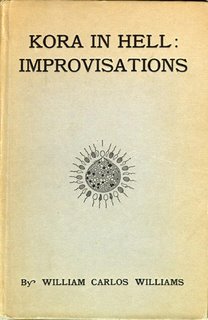My blog's name, Kora in Hell, has a number of allusions but the most prominant one is a book by the American poet William Carlos Williams.
Kora in Hell was written in 1918 and published in 1920. It is a unique text written in a form that defies categorization. Subtitled "Improvisations" the closest way to describing the text in familiar genre terms is as a prose poem. Specifically it is a series of paragraph entries comprised of two types of writings: (1) spontaneous writings that he composed over the course of a year -- a kind of poetic diary; and (2) italicized critical commentaries on the "diary" passages. The fragmentary form is an attempt to demonstrate the process of the imagination as it moves "from one thing to another." In doing so Williams is tracing the discovery -- and the movement towards understanding -- that the opposite of a perception can also true. In this way Kora in Hell juxtaposes the tension between -- and interdependence of -- the imagination and the objective facts--the hard objects--of the world.
The "Prologue" to Kora in Hell is considered one of the most significant statements on modern poetic form. At the time Williams was interested in Dada and the ideas of the artist Marcel Duchamp. Kora in Hell was written at the peak of this intense and significant but short-lived avant-garde movement and it is the most fully realized work of Dada poetics. It bears the hallmarks of the movement's in its absurdity, irony, chance, and the need to create art that challenges conventional ideas about art itself. It is profoundly unsentimental and scoffs at exalted conceptions of art:
There is nothing sacred about literature, it is damned from one end to the other.
 As befitting a work that evokes the myth of Kora's descent into hell (Kora is a figure for Percephone -- although Williams also connects the theme to Euridice), the work is often deeply pessimistic and despairing about the human condition. It is important to note that the book (and the Dada movement) were created during the time of World War I.
As befitting a work that evokes the myth of Kora's descent into hell (Kora is a figure for Percephone -- although Williams also connects the theme to Euridice), the work is often deeply pessimistic and despairing about the human condition. It is important to note that the book (and the Dada movement) were created during the time of World War I.In keeping with the Percephone myth rebirth is a recurring motif in the work, as is the theme of returning: the flip side of the coin of renewal. This is the necessary journey of the artist who must create a break from the past in order to see the world anew. Indeed, Kora in Hell marks a major transition in Williams as a modern poet.
There is so much more to say about this book but for now let this stand as a brief "advertisement" for you to go read it for yourself.
To cite this passage please contact me here.




4 comments:
I'll have to read the book
I'll have to read the book
I read this and loved it.
Thank you for the picture.
Post a Comment